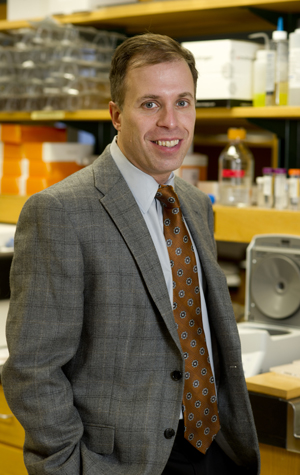BU Takes On Cancer: Finding Lung Tumors Sooner
Genes and proteins may be early warning system

In part two of a five-part series, BU Today examines the many ways BU researchers areworking to demystify, treat, and prevent cancer.

Lung cancer is the deadliest cancer in the United States. According to the National Cancer Institute, it will kill about 160,000 people in 2012, more than the next four cancers combined. Avrum Spira wants to lower these numbers by diagnosing it earlier and preventing its development.
For the last decade, Spira, a School of Medicine professor of medicine, pathology, and bioinformatics and a pulmonologist at Boston Medical Center (BMC), has worked to develop molecular tests that detect lung cancer early. And now, with a $20 million grant from the Department of Defense, he is carrying the research forward as leader of a five-year study called Detecting Early Lung Cancer Among Military Personnel (DECAMP).
“One of the reasons that lung cancer is so deadly is because we rarely find it early, when it’s still treatable,” says Spira (ENG’02). Only 15 percent of people in the United States with lung cancer are diagnosed at stage 1, according to the National Cancer Institute. Compare this to, say, breast cancer, where doctors catch a majority of cases at an early stage. “Lung cancer is well behind the other cancers,” Spira says. “Early diagnosis is where this field needs to be.”
Why is lung cancer so hard to catch? After all, people pay attention to their lungs: if somebody can’t breathe or they start coughing up blood, they usually call a doctor. The problem, according to Spira, is that the lungs are deep within the body, so it’s difficult to collect tissue samples without an invasive procedure. By the time someone has noticeable symptoms, the cancer has usually grown large and spread. Adding to its deadly force, lung cancers are usually very aggressive, often moving quickly to other organs.
In addition, many other lung diseases mimic lung cancer, making it difficult to diagnose. An abnormal finding on a CT scan or a chest X-ray might be lung cancer or it might be pneumonia. The National Cancer Institute’s recently completed National Lung Screening Trial, which did chest CT scans of more than 25,000 high-risk smokers over three years, found that the scans did catch many cancers early, reducing lung cancer mortality, but there was a tradeoff. While 25 percent of current and former smokers showed an abnormality on the CT scan that doctors were concerned might be lung cancer, only 4 percent turned out to be lung cancer. The other 96 percent were false positives.
“This comes at a huge cost for the patient and the health care system,” says Spira, who notes that positive CT scans are often followed by bronchoscopy, more imaging studies, or a lung biopsy, which is an invasive surgical procedure. There had to be a better way. Spira found one.
For years, he says, lung doctors and scientists studying lung cancer have worked with a theory called the “field of injury.” The idea is this: when somebody smokes, they don’t damage just their lungs; they hurt all the cells lining the respiratory tract, from nose to trachea and beyond. Spira thought these epithelial cells lining the windpipe might be able to serve as a surrogate for a tumor hidden deep within the lungs, and like a canary in a coal mine, help identify who is at risk.
Working with colleague Jerome Brody, a MED professor of medicine, Spira began to test his theory nearly a decade ago. While performing bronchoscopies on healthy active smokers and nonsmokers, he took small samples of epithelial cells from brushings of their bronchial airways or windpipes, then compared samples from smokers with those from nonsmokers. “We found a huge number of changes in gene activity in these airway cells among the smokers,” he says. “A bunch of the genes that detoxify cigarette smoke had been turned on.”

不
Major problem among soldiers and veterans
一个
Spira is starting work on the huge DECAMP study. BU is the lead institution on the multicenter study, which involves seven veterans hospitals, four military hospitals, and five additional research institutions.
Lung cancer is a major problem among soldiers and veterans, whose smoking rates are about 50 percent higher than those of civilians. Veterans are 25 to 75 percent more likely to develop lung cancer as nonveterans, according to MED, and combat soldiers are also exposed to other airborne toxins, such as radon, asbestos, and fuel exhaust.
The DECAMP research has two tracks. The first will follow 500 veterans with abnormal but ambiguous CT scans, showing small nodules that may or may not be cancerous. This group will be tested with Spira’s BronchoGen test and three other biomarker tests that seem especially promising.
The larger, second section will cast a wider net. It will examine veterans over 55 who have no symptoms of lung cancer, but are at high risk for developing the disease because of past exposure to airborne toxins. Scientists will collect epithelial cells from the airways to look for a wide array of new biomarkers—not just genes, but abnormal proteins as well. “This is more of a discovery effort,” says Spira. “We’ll of course look at the known biomarkers, but we want to be open-minded and look at everything.”
Statistically, within this high-risk group of 1,000 veterans and active military personnel, he expects that about 50 will develop lung cancer by the end of the five-year study. He and his colleagues will then be able to compare the cells of those who developed cancer to those who did not and see what biomarkers pop up as different.
Eventually, Spira hopes to develop a screening test that is sensitive enough that doctors can test cells from a patient’s nose, rather than the airway. “The long-term goal,” he says, “is to develop a simple tool where a doctor can swab your nose, look at the gene activity and say, ‘You’re on your way to getting cancer,’ and then potentially offer treatment to reverse the damage and prevent lung cancer development.” An even bigger achievement would be for other researchers to expand the concept of the “area of injury” to other organs, he says, perhaps testing for liver or pancreatic cancer with a simple blood test rather than an invasive, costly biopsy.
Tomorrow, in part three of “BU Takes On Cancer,” how one protein may lead to new treatments for liver cancer.
Barbara Moran (COM’96) is a science writer in Brookline, Mass. She can be reached through her website WrittenByBarbaraMoran.com.
This article was originally published on April 10, 2012.

Comments & Discussion
Boston University moderates comments to facilitate an informed, substantive, civil conversation. Abusive, profane, self-promotional, misleading, incoherent or off-topic comments will be rejected. Moderators are staffed during regular business hours (EST) and can only accept comments written in English. Statistics or facts must include a citation or a link to the citation.